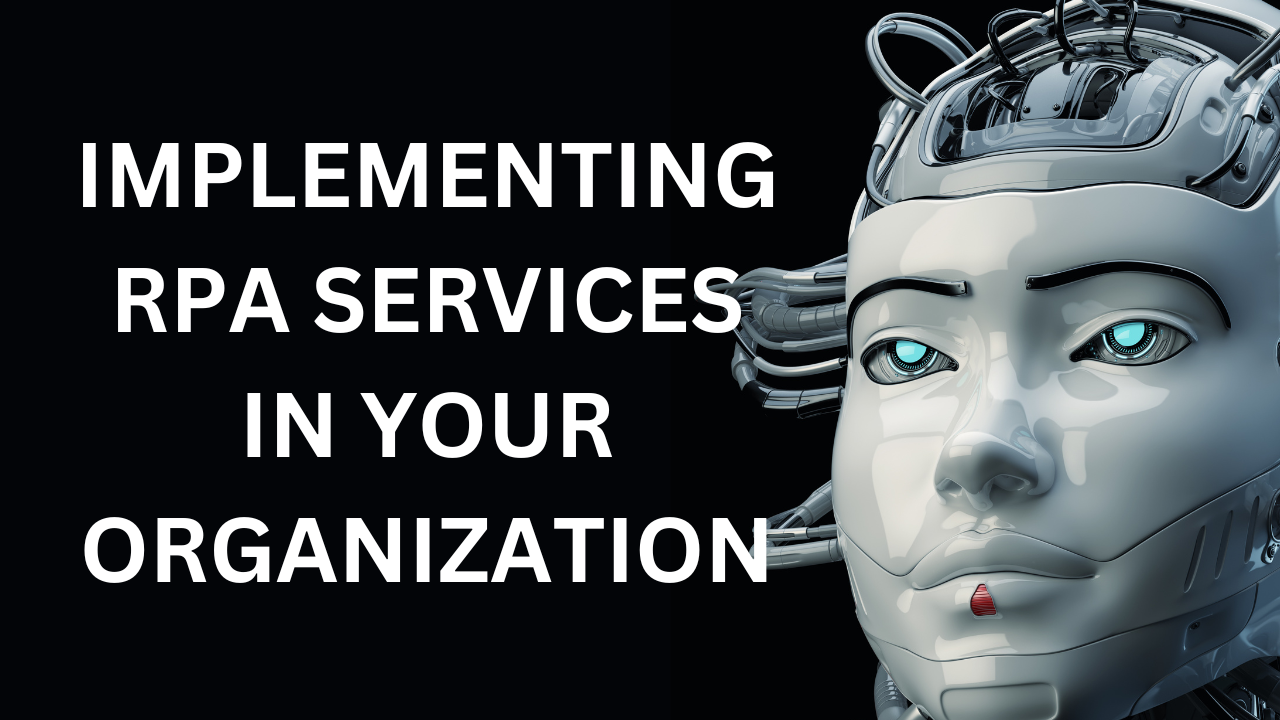Reducing Operational Costs with the Help of RPA Services

In today’s business environment, companies must constantly find new ways to cut costs and increase efficiency. One emerging technology that is proving to be a game-changer is Robotic Process Automation (RPA). RPA is a type of software that automates repetitive and rules-based tasks to improve efficiency and reduce human error. In this article, we’ll explore how RPA Services can reduce operational costs and improve efficiency in your organization.
Understanding RPA Services and Its Benefits
What is Robotic Process Automation (RPA)?
Robotic Process Automation (RPA) is a technology that has revolutionized the way businesses operate. It is a software technology that uses robots or bots to replicate the actions of a human performing repetitive tasks. The system uses artificial intelligence and machine learning to make decisions and learn from past actions. The technology can automate processes, such as data entry, document processing, and customer service interactions, among others, which are often repetitive, time-consuming, and prone to errors.
RPA Services, or Robotic Process Automation Services, have emerged as a game-changing technology in the business world. RPA Services leverage the power of software robots to automate repetitive, rule-based tasks, freeing up human resources to focus on more strategic and creative endeavors. With the rapid rise of mobile technology, the demand for RPA Services in mobile application development has skyrocketed. RPA Services can streamline and accelerate various aspects of the mobile app development lifecycle, such as testing, quality assurance, and deployment.
One of the most significant advantages of RPA is that it can be used across a wide range of industries, from healthcare to finance, manufacturing to retail. The technology is highly versatile and can be tailored to meet the specific needs of each business.
Key Benefits of Implementing RPA Services
RPA technology can bring a wealth of benefits to your organization. Here are some of the most significant benefits of implementing RPA services:
- Increased efficiency: By automating repetitive and rules-based tasks, RPA improves process efficiency and accuracy, freeing up employees to focus on higher-value activities. This can lead to increased productivity and faster turnaround times.
- Cost savings: By automating repetitive tasks, RPA can help reduce the need for manual labor, which can result in significant cost savings. This can be particularly beneficial for businesses that are looking to reduce their overheads.
- Improved accuracy: RPA provides consistent and error-free output, reducing the need for manual intervention and the associated risk of errors. This can help to improve the quality of your business processes and reduce the risk of costly mistakes.
- Flexibility: RPA can be customized and adapted to specific business needs, making it a highly versatile technology. This means that businesses can use RPA to automate a wide range of different processes, from simple data entry tasks to more complex customer service interactions.
- Scalability: RPA can quickly scale to accommodate increased workloads, making it suitable for businesses of all sizes. This means that businesses can use RPA to automate processes as they grow, without having to worry about the technology becoming outdated or obsolete.
Implementing RPA services can be a significant investment for businesses, but the benefits can be substantial. By automating repetitive and time-consuming tasks, businesses can free up their employees to focus on higher-value activities, improve process efficiency and accuracy, and reduce the risk of costly errors. Additionally, RPA can be customized and adapted to meet the specific needs of each business, making it a highly versatile technology that can be used across a wide range of industries.
Identifying Opportunities for RPA Implementation
Analyzing Business Processes for Automation Potential
Before implementing RPA, it’s essential to identify the processes that are most suitable for automation. Common areas where RPA can make a significant impact include finance, human resources, supply chain management, and customer service. Companies should start by examining their existing processes and determining which tasks are most time-consuming and error-prone.
For example, in the finance department, RPA can be used to automate tasks such as invoice processing, account reconciliation, and financial reporting. In human resources, RPA can be used to automate tasks such as employee onboarding, payroll processing, and benefits administration. In supply chain management, RPA can be used to automate tasks such as purchase order processing, inventory management, and shipment tracking. In customer service, RPA can be used to automate tasks such as ticket routing, response generation, and complaint resolution.
RPA Services, also known as Robotic Process Automation Services, play a crucial role in streamlining and optimizing business processes. With the rapid advancements in technology, organizations are increasingly turning to RPA to automate repetitive and rule-based tasks, thereby enhancing productivity and efficiency. These services utilize software robots or “bots” to mimic human actions and interact with various systems and applications. RPA Services can be particularly beneficial for app developers, as they help automate routine tasks like data entry, testing, and integration, allowing developers to focus on more complex and innovative aspects of application development. By leveraging RPA Services, app developers can expedite their development cycles, improve accuracy, and ultimately deliver high-quality applications to meet the ever-growing demands of today’s digital landscape.
By automating these tasks, companies can free up their employees’ time to focus on more strategic and value-adding activities, such as analyzing data and making informed decisions. In addition, RPA can help improve accuracy and reduce errors, resulting in better quality outcomes and improved customer satisfaction.
Selecting the Right RPA Tools and Vendors
There are many RPA vendors and tools available in the market, each with its own strengths and limitations. To get the best results, it’s crucial to select the right tool that aligns with your organization’s goals and objectives. Companies should consider factors like ease-of-use, flexibility, scalability, and cost-effectiveness when selecting an RPA tool.
For example, some RPA tools are designed specifically for certain industries, such as healthcare or finance, and may offer features and functionalities that are tailored to those industries’ unique needs. Other RPA tools may be more generic and offer a broader range of functionalities that can be customized to fit any industry. Companies should also consider the level of support and training offered by the RPA vendor, as well as the vendor’s track record of successful implementations.
Ultimately, the key to selecting the right RPA tool is to thoroughly evaluate your organization’s needs and objectives and choose a tool that aligns with those goals. By selecting the right tool and vendor, companies can ensure a successful RPA implementation that delivers significant benefits in terms of efficiency, accuracy, and cost savings.
Implementing RPA Services in Your Organization

Developing an RPA Implementation Roadmap
Implementing RPA requires a strategic approach to ensure that the technology is integrated effectively into the business. Developing a roadmap that outlines the key steps in the implementation process can help organizations avoid common pitfalls and ensure a successful rollout.
Building an RPA Center of Excellence
An RPA Center of Excellence (CoE) is a dedicated team responsible for managing and maintaining RPA within an organization. Building an RPA CoE can help streamline the implementation process, ensure compliance, and better leverage the benefits of the technology.
Ensuring Effective Change Management
Implementing RPA often involves significant changes in the way people work and can impact job roles and responsibilities. To ensure a smooth transition, organizations need to develop effective change management processes. This involves communicating effectively, providing adequate training, and involving stakeholders at all levels of the organization.
Measuring the Impact of RPA on Operational Costs
Key Performance Indicators for RPA Success
Measuring the success of RPA involves tracking several key performance indicators (KPIs). These KPIs can include measures of efficiency, accuracy, cost savings, and employee satisfaction. By tracking these metrics, organizations can assess the impact of RPA and identify areas for improvement.
One key KPI to track is efficiency. RPA can significantly improve efficiency by automating repetitive and time-consuming tasks. By reducing the time it takes to complete these tasks, employees can focus on higher value activities, which can improve overall productivity. Additionally, RPA can help improve accuracy by reducing the risk of human error in manual processes.
Another important KPI to track is cost savings. RPA can help organizations save money by reducing the need for manual labor and increasing operational efficiency. By automating tasks, organizations can reduce the number of employees needed to complete them, which can result in significant cost savings over time. Additionally, RPA can help reduce the risk of errors, which can lead to costly mistakes and rework.
Employee satisfaction is also an important KPI to track. By automating repetitive and mundane tasks, RPA can help reduce employee burnout and improve job satisfaction. Employees can focus on higher value tasks, which can lead to a more fulfilling work experience. Additionally, RPA can help reduce the risk of errors, which can lead to less frustration and stress for employees.
Calculating Return on Investment (ROI) for RPA Projects
Calculating the ROI of RPA is an essential step in determining the value of the technology. ROI calculations typically involve comparing the costs and benefits of RPA over a specified time frame. These calculations can help organizations determine the payback period and make informed decisions about RPA investments.
When calculating ROI, it’s important to consider both the direct and indirect benefits of RPA. Direct benefits can include cost savings from reduced labor and increased efficiency. Indirect benefits can include improved customer satisfaction and increased revenue from faster time-to-market for new products and services.
It’s also important to consider the costs associated with implementing RPA. These costs can include software licensing fees, hardware costs, and employee training. By comparing the costs and benefits of RPA, organizations can determine whether the technology is a worthwhile investment.
Overall, calculating ROI can help organizations make informed decisions about RPA investments and ensure that they are getting the most value from the technology.
Real-World Examples of RPA Reducing Operational Costs
RPA or Robotic Process Automation is a technology that is being widely adopted by businesses across various industries. It involves the use of software robots or bots to automate repetitive and rule-based tasks, thereby reducing operational costs and improving efficiency. Let’s take a look at some real-world examples of how RPA has been used to reduce operational costs in different industries.
RPA in Finance and Accounting
The finance and accounting industry is one of the early adopters of RPA technology. Many companies in this industry have already implemented RPA, resulting in significant cost savings and efficiency improvements. For example, American Express has used RPA to automate its back-office processes, including accounts payable, accounts receivable, and general accounting. This has resulted in $1.8 billion in savings over six years. Similarly, Deutsche Bank has implemented RPA to automate its payment processing, reducing the processing time from hours to minutes.
RPA in Human Resources
RPA is also being used in human resources to automate repetitive tasks like data entry and payroll processing. For example, oil and gas company Shell has used RPA to automate its recruitment process. The software bots screen resumes, schedule interviews, and send out offer letters, reducing the time required to process job applications by 90%. This has not only reduced operational costs but has also improved the candidate experience by providing faster feedback.
RPA in Supply Chain Management
Supply chain management involves a complex set of processes, including inventory management, order processing, and logistics management. RPA is being widely adopted in this industry to automate these tasks, resulting in significant cost and time savings. For example, Walmart has implemented RPA to automate its inventory management, reducing the time required to complete a task from hours to seconds. Similarly, DHL has implemented RPA to automate its order processing, reducing the processing time from hours to minutes. This has not only reduced operational costs but has also improved the accuracy and speed of order processing.
Overall, RPA has proven to be a valuable technology for businesses looking to reduce operational costs and improve efficiency. As the technology continues to evolve, we can expect to see more industries adopting RPA to automate repetitive tasks and streamline their operations.
Conclusion
RPA is a powerful technology that can significantly reduce operational costs and improve efficiency in organizations of all sizes. However, implementing RPA requires a strategic approach and careful planning to ensure success. By following the steps outlined in this article, companies can streamline the implementation process and leverage the many benefits of RPA to gain a competitive edge in today’s business environment.

